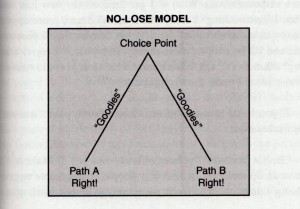PTSD and Decision Making: How To Put Power In Your Process
Since your trauma have you noticed that the smallest decisions have become ENORMOUS????
Since your PTSD symptoms surfaced, have you noticed that even the tiniest choice seems to exacerbate your feelings of panic, anxiety, fear and apprehension?
If you answered ‘Yes!’ to either of these questions you are soooo part of a crowd (a/k/a: you are not alone!).
Getting A Grip On Your Choices
 Making any choices in life, large or small, force us to really get clear on our options and to imagine outcomes – both good and bad. In fact, we’re taught that we’re supposed to make ‘good’ decisions, and not make ‘bad’ decisions. Our language surrounding our choice-making sets us up for worry.
Making any choices in life, large or small, force us to really get clear on our options and to imagine outcomes – both good and bad. In fact, we’re taught that we’re supposed to make ‘good’ decisions, and not make ‘bad’ decisions. Our language surrounding our choice-making sets us up for worry.
“What if this is the wrong decision?”
“What if this is a bad choice?”
That little voice in your head can worry and nag you until you’re just about to crumple – and make no decision at all! (Or, if you’re like I was in the depths of PTSD, you let other people make your decisions, which leads to its own ‘wrong’ turns.)
It’s a natural fact that decision-making can elevate stress levels in even the most healthy of people as we look at choices and hope we’re doing the right thing. (Check out this interesting article about how decision-making affects your health.)
With PTSD, however, this process becomes exaggerated. Since we feel out of control and in danger the smallest choice isn’t just about the choice itself but ties into our future feelings of control and safety. Whew, that can become a very heavy burden to carry!
Last week I read FEEL THE FEAR… AND DO IT ANYWAY, by Susan Jeffers, and I really loved her idea of how to approach decision making. Instead of a No-Win process (the choice is either right or wrong) her No-Lose model (pictured above) offers a new perspective:
What if every decision you make is right, and there are different benefits to the outcomes? Looking at it that way, if you weigh NOT the pros and cons but INSTEAD take a long, detailed look at all the ‘goodies’ that come with either choice, you shift into an empowered state for decision-making. From that place of confidence you can make many and much better decisions much faster that what used to happen to me: sit on a decision for far too long because I was paralyzed by fear of making the wrong decision, only to then have someone else become exasperated by my indecision and make the decision for me.
PTSD robs you of your power. Jeffers’ solution is one simple way of beginning to gain it back. Shifting into the empowered state of the No-Lose model, actually, is the crux of PTSD recovery.
Taking back control in PTSD recovery starts at the smallest level. Learning good decision-making processes also starts that way.
So, the next time you have to make a decision, will you be using the No-Lose idea?
Michele is the author of Your Life After Trauma: Powerful Practices to Reclaim Your Identity. Connect with her on Google+, LinkedIn, Facebook, Twitter and her website, HealMyPTSD.com.
APA Reference
Rosenthal, M.
(2012, September 19). PTSD and Decision Making: How To Put Power In Your Process, HealthyPlace. Retrieved
on 2025, December 13 from https://www.healthyplace.com/blogs/traumaptsdblog/2012/09/ptsd-decision-making-how-to-put-power-in-your-process